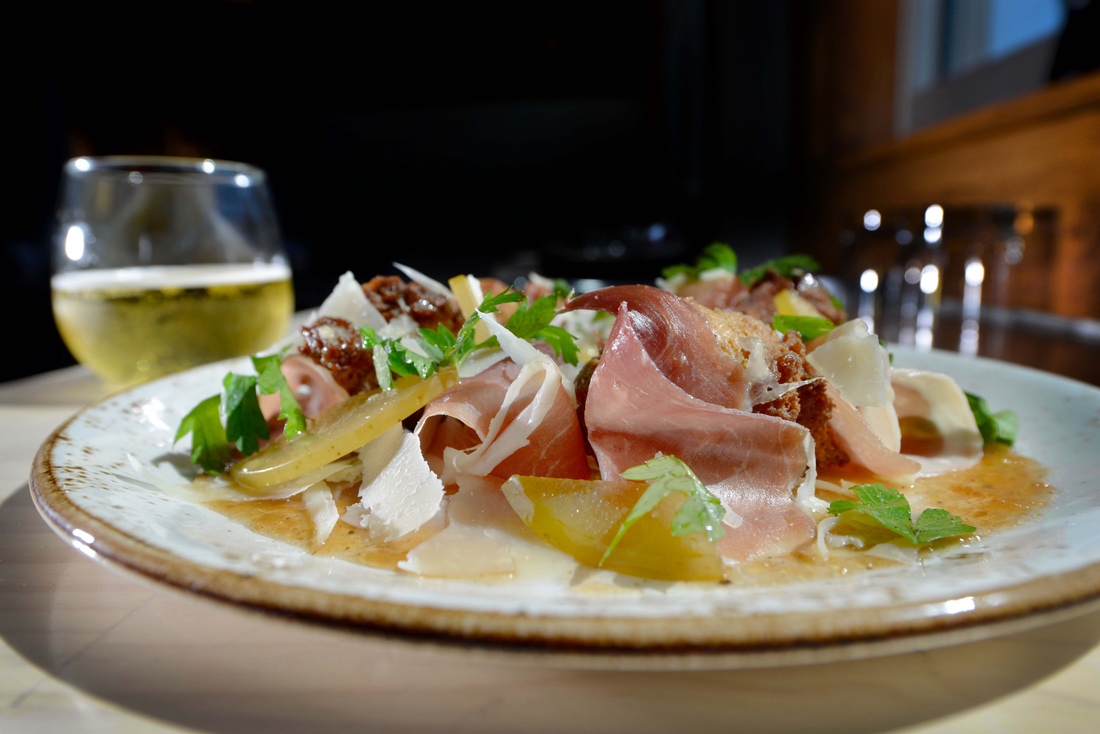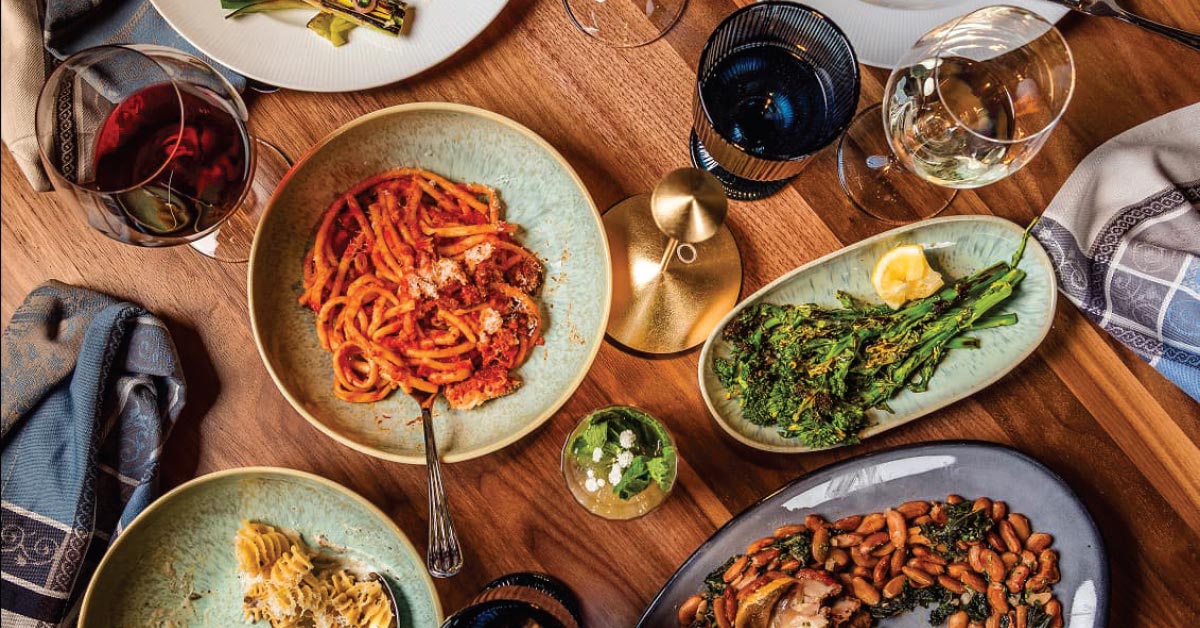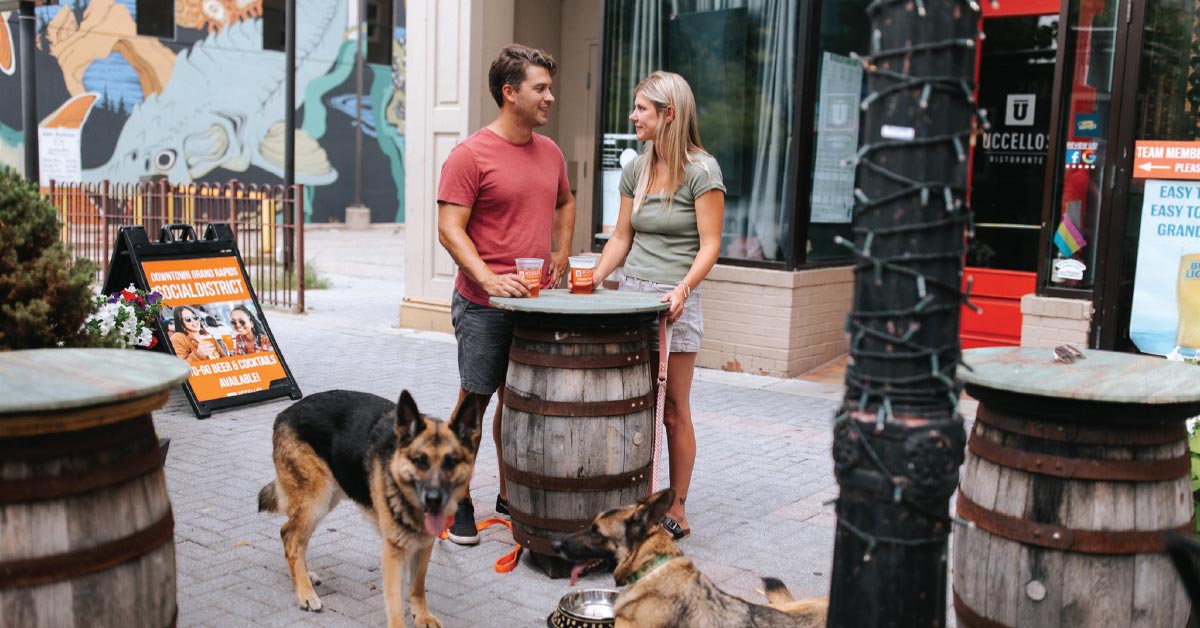When planning his new kitchen, Rockford Brewing Company owner Seth Rivard knew, first of all, what wasn’t going to work.
“We’re not just buying a bunch of frozen shit, throwing it in a fryer and saying, ‘Here you go!’” he told Revue.
Just a few years ago, most breweries could get away with treating their food menu as a greasy afterthought — maybe a few token appetizers or sandwiches to keep the regulars warming the barstools.
But breweries in Beer City and throughout West Michigan are learning, sometimes the hard way, that a successful operation needs more than just good beer to distinguish itself in 2016. It’s a field that seems to become more crowded with every passing month. Now that the region is flush with craft beer and cider, what emerges from a brewery’s kitchen is just as important as what comes out of its taps.
Expanding the Experience
Brewery Vivant set an early standard, serving farm-to-table entrees and desserts along with its menu of Belgian and French-inspired beers when opening six years ago. So many other Grand Rapids breweries have followed suit: Grand Rapids Brewing Co., Perrin Brewing Co., The Mitten Brewing Co., Founders Brewing Co., Harmony Brewing, etc. The latter’s new West Side location, Harmony Hall, offers a high-end take on sausages and was voted favorite new restaurant (yeah, restaurant) in Revue’s Best of the West survey earlier this year.
When Rockford Brewing opened in 2012, it had no kitchen of its own, instead partnering with a local pizzeria for delivery. But Rivard said he always planned for the brewery to offer its own food once it was established as a beer destination.
“The few years that we’ve been open, our customers have been telling us, ‘We really want you guys to have food,’” Rivard said. “They’d say, ‘Hey, we just went out to eat and came here afterwards.’ … It makes a lot of sense to offer both.”
After a summer of construction, Rockford Brewing this month will open a spacious new kitchen on the north end of its building in the city’s cozy downtown. In view of outdoor passersby, the new staff prepares charcuterie and cheese boards, chorizo Scotch eggs and ramen bowls under the leadership of Ryan Bolhuis, the brewery’s first executive chef.
A Hudsonville native, Bolhuis studied at the French Culinary Institute in Manhattan and spent years working in the kitchens of some of New York’s most prestigious restaurants, including Nobu Fifty Seven, Babbo and The Modern. After returning to Michigan, Bolhuis worked briefly at Pike 51 Brewery before Rivard hired him to build Rockford Brewing’s new menu, which will emphasize local produce. Bolhuis said he’s eager to blend the worlds of fine dining and craft beer.
“Almost like that appreciation for wine and food, people are starting to realize beer and food pairings open you up to a whole new world of flavors and textures,” he said.
In Grand Rapids, where the market is more competitive, ambitious food menus are the new normal for anyone opening a craft taproom. The new Creston Brewing and the upcoming City Built Brewery Company feature menus of Latin and Puerto Rican-inspired cuisine, respectively. New Holland Brewing’s Bridge Street location in Grand Rapids opened in mid-September with a food menu trendily described as “focused on mindful sourcing, scratch cooking, rustic traditions — including heirloom produce and whole animal butchery of heritage breeds.”
Enlightening Patrons
Vander Mill went big when the popular Spring Lake hard cider maker opened its 40,000-square-foot Grand Rapids taproom and brewing facility in the spring. Owner Paul Vander Heide recruited Chef Justin Large — a veteran of hip Chicago establishments such as The Publican, The Violet Hour and Big Star — to craft the food menu, which he’s built loosely around a French farmhouse concept. Large said opening with a strong menu was crucial, since Vander Mill, despite its name recognition, is located in a part of Northeast Grand Rapids that does not attract much foot traffic.
“I think food has to be a serious part of the conversation right out of the gate,” Large said. “You’re going to see the paradigm really shift in Grand Rapids, in that people are going to want all facets. They’re going to want great beverages, great food, great service, not just one of the three. I think the consumer is becoming a little more savvy.”
Also at their fingertips: hot wing poutine and ham and doughnuts, two starters that have caught on among Vander Mill customers looking for a sharable snack, or easing into a multi-course dining experience that might also include a pork chop, char-grilled chicken, mushroom bolognese or pot roast entree — all upscale twists on hearty farm-style dinner fare.
“We wanted to play up the farm scene and what’s happening agriculturally in this part of Michigan,” Large said. “I want to bring something a little more high-minded to the city, not because I think it’s better or cool, but because I think people will genuinely like it if they give themselves up to the experience. I like sandwiches as much as the next guy, but I would like to see this town grow up a little bit and not have a sandwich with every meal.”
Now that brewers have proved their capabilities in Grand Rapids, culinary risk-taking is going to be a key to surviving in a still-growing craft beverage scene, Large said. Along with a second Elk Brewing location in Comstock Park and New Holland in Grand Rapids, openings loom for Atwater Brewing and City Built in Grand Rapids.
“I think we’re going to see the bubble burst here soon on the brewery scene,” Large said. “We’re still not talking about that big of a city. I think that Grand Rapids, mentally, thinks it’s bigger than it truly is. You’re competing for 250,000 people as well as against openings of every other size, shape and color. It’s not necessarily open season — it makes for a very hyper-competitive market.”
Enticing Urbanites
It also opens a window for brewers outside Grand Rapids who want to step up their food game. Newaygo Brewing Co. President Nick Looman said that since opening in 2015, the majority of his brewery’s weekend food sales are to visitors from Grand Rapids who are either numbed by the abundance of the city’s dining scene or eager to see how nearby towns stack up.
“We weren’t going to open with food at all, but Grand Rapids made it standard that good breweries made good food,” he said.
When he added a kitchen to his brewery plan, Looman hoped food would account for 40 percent of sales, but “because of the local demand for great food to accompany great beer, we now have a 100-seat taproom with 60 percent food sales, and we run a higher-end farm-to-table restaurant.”
Newaygo Brewing’s kitchen manager, Chris Brandmiller, is a former Grand Rapids resident who moved to Newaygo to build the brewery’s menu and found he missed the culinary variety of the city, so he began experimenting. When his Oktoberfest plate last year became a local hit, he saw it as a sign Newaygo was ready to try new things. “They went crazy for it. That kind of gave us a cool opportunity to keep pushing Newaygo and seeing, what’s their threshold?”
The taproom now boasts a menu of farm-to-table specialty pizzas, pastas and gourmet desserts, which, along with the brewery’s diverse beer list, performs a difficult task.
“We have to provide approachable beer and food for people up here who are still getting into craft, but also provide excellent beer and food for those who have already come to expect that in craft,” Looman said.
As the market expands and evolves, there are opportunities as well as challenges. Rockford’s Bolhuis foresees teaming with brewers in and around Grand Rapids on collaborative beer dinners or guest-chef dishes.”
What I love about working for a brewery is the beer culture in and of itself. How much brewers collaborate with each other is awesome, and I definitely want to bring that to the kitchen here,” he said. “We’re all here to help each other, teach each other, learn from each other and push the industry forward.”
In other words, Bolhuis said, something about the brewing industry makes it less stereotypically cutthroat than the restaurant business.
“Better access to alcohol maybe helps,” he said.





